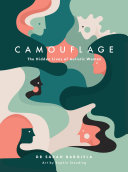Dr. Sarah Bargiela’s “Camouflage: The Hidden Lives of Autistic Women” is a great, entry-level guide to autism in women if you are not someone already exposed to this content on the Internet. Even though it has illustrations by Sophie Standing, the book’s message targets young adult women. It is marketed as appropriate for children starting at eleven years old, but I will defer to people with more child caretaking experience to decide if the marketing is accurate. At forty-eight pages, anyone could read it and decide if the book is appropriate without siphoning off great quantities of your leisure time.
If you follow autistic women creators on TikTok, “Camouflage” will seem slight and suffer in comparison, but as an introduction to the concept that *gasp* women can be autistic too because they are human beings with the capacity to have the same medical diagnoses as men, it is a nice way to start exploring the developmental disorder. The book provides a variety of experiences by depicting the lives of four autistic women after a brief history about the discovery of the disorder and listing universal and gender prevalent characteristics of autism to facilitate detection.
“Camouflage” uses an unnecessary framing device. The book starts with Amy, a journalist who created an online forum for autistic women but does not mention the name of the forum. Maybe Amy did not want her identity revealed, but a footnote could have referenced the forum. It is frustrating that someone created a valuable resource for autistic women, but the book never shows us how to find it. The book uses Amy as a guide as we meet three other women. She is more of a host than an interviewer. This framing device is easy to forget though Amy’s illustrated figure appears throughout the book as a literal guide. Readers more fascinated with the imagery may not forget her as opposed to those readers more focused on the words.
“Camouflage” makes two separate points about gender differences: that women are better at “masking” or hiding their autistic traits, and those traits are expressed differently according to gender. The book misses the opportunity, and perhaps it is outside the book’s scope, to explore whether women are better at masking because girls are more likely to be punished for breaking social rules than boys so as they get older, boys do not feel the need to change their behavior to accommodate neurotypicals whereas most girls, neurotypical or not, are taught to prioritize accommodating others over meeting their own needs. If a boy is not social to the point of outbursts or physical violence, he is being a boy, but if a girl is not social, she is bad and corrected. The authors may not have wanted to alienate readers since the priority is raising awareness of the disorder than exploring the reasons behind the disparity in diagnosis and behavior.
“Camouflage” details some great external signs of autism, but when they try to show which ones are different between men and women, I thought that it missed the mark. The chart needed a key to explicitly define the meaning behind the symbol of a checkmark versus an x before detailing which traits are shared or not according to gender. It requires context and relating, which is exactly what autistic people have difficulty tackling. The Venn diagram which appears in the final pages is clearer.
While I enjoyed the illustrations, “Camouflage” Amy, Paula, Ellie and Mimi’s avatars did not reflect their stated ages, which made it difficult to differentiate among them without consulting the introduction. This detail would provide continued context for their experiences, which would be a function of age and gender. Race is shown, but the book does not explicitly explore whether there is a further difference in how people treat autistic women of color and how autistic women of color navigate the world.
“Camouflage” tackles their stories by segmenting them into four “headlines,” categories, instead of doing a complete profile of each woman. This choice was the most effective portion of the book. I enjoyed this framing device since it gave us a spectrum of experiences within each category, and I found every story relatable even if I did not share similar experiences. If the stories resonate for you, you may be autistic. These categories are family, friends and professionals dismissing their diagnosis, masking, empowerment after diagnosis and special interests defining identity.
In the third headline, “From Passive to Assertive,” “Camouflage” tackles sexual coercion to violence. Because autistic people have problems reading social cues, those problems get compounded in heterosexual relationships, which are the only ones described in this book. Same sex relationships are omitted, and the data on that never appears in a footnote. Disabled, which includes autism, women are more likely to be targets of sexual violence.
The book shies from discussing sexual orientation and never detail the gender of the person whom the autistic woman feels pressured to please. Heterosexuality is the presumption though only one panel in the illustration explicitly uses “he.” The book shies away from any general discourse that may shine a negative light on how gender norms enforce a specific gender (#notallmen) inflicting sexual abuses on another. Based on crime statistics, it is probably men, but if the book examined that dynamic, it would be controversial. The book unintentionally replicates the dynamics of the real world. Cis men cannot be called dangerous or abusive without accusations of bias, regardless ff facts, only transwomen because of their assigned at birth gender despite facts. Are autistic women misreading the social cues or are they reading and obeying the social cues perfectly if the problem falls along the lines of gender regardless of neurotype?
If you are not into social media, and you are a girl or a woman who feels out of step with everyone as if they got a rulebook that you did not, check out “Camouflage.”




